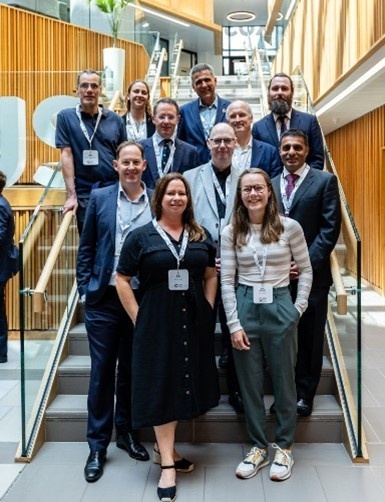On 16 June 2025, the CGFI Leeds Innovation Hub and the Bank of England co-hosted a landmark event at Nexus, University of Leeds, to explore the implications, challenges, and opportunities emerging from CP10/25—the Bank of England’s new consultation paper on climate scenario use in financial services.
Discussion
The event brought together over 120 regulators, academics, and financial institutions to deepen dialogue around CP10/25 and promote cross-sector collaboration. In doing so, it underlined the national role of the CGFI and the Leeds Innovation Hub for integrating cutting-edge climate analytics with real-world financial system needs.
Sessions addressed dimensions of climate-related financial risk: supervisory framing and guidance, transition risk modelling, physical risk science and analytics, and integration of climate, nature, and economic pathways. These sessions shared relevant academic insights and shape debate and discussion on the potential interpretation and potential application of CP10/25.
“The UK CGFI’s trusted platform played a key role in supporting the Bank of England’s CP10/25 process. The Leeds Hub provided category 1 and 2 banks, building societies, insurers, and trade associations with the opportunity to engage with academic specialists and representatives from the Bank to discuss proposed changes.”
Trish Grant – UK CGFI Leeds Innovation Hub Manager
Session 1: Welcome, Keynote & CP10/25 Development Insights
This opening welcomed participants and the session positioned CP10/25 as a live consultation document within a broader policy and supervisory narrative, and invited engagement with the financial sector, academia, and public organisations. The session underscored that climate-related risk supervision is evolving rapidly, and CP10/25 is designed as a pathway to maturity, rather than a destination.
Prof Iain Clacher (University of Leeds | CGFI-Leeds)) and Prof Nick Plant (University of Leeds) welcomed attendees and outlined our work to bridge academic rigour and insight to financial decision-making – including our pivotal role in bringing regulators and researchers together to accelerate knowledge transfer, and the University’s strategic role in advancing research for societal good.
The strategic intent behind CP10/25 and evolution of the UK’s climate-related supervisory guidance from SS3/19 was introduced. CP10/25 represents a critical next step in embedding forward-looking, scenario-based approaches into risk management and board-level decision-making, and challenges firms to use CP10/25 as a catalyst for innovation and better governance beyond compliance.
The session discussed the development of CP10/25 building on lessons from past supervisory work and feedback from industry. It aims to encourage firms to experiment, learn, and align their practices with the latest science and policy developments, with a focus on decision-useful, plausible, and adaptive frameworks. One approach is via a “taxonomy-based scenario chain” – a modular evaluation process supporting model transparency and alignment with specific financial applications (e.g. for UK mortgage portfolio risk).
Practical challenges in implementing SS3/19 so far have included fragmented data, low scenario usability, and insufficient integration with core decision processes. CP10/25 is structured to support progress on these pain points, with phased architecture and embedded milestones to help firms operationalise climate considerations in risk appetites and strategic direction.
Through this work, there is a “golden thread” through risk identification, governance frameworks, and communication strategies; without clarity and accessibility, even the most sophisticated scenarios could become disconnected from actual decision-making. In particular, it will be important to translate climate risk into language and formats that are useful at the boardroom, operational, and supervisory levels.
Q&A
Focused on how prescriptive the supervisory expectations would be; whether firms would be required to use particular models; and how new data sources such as AI-generated projections would be validated. Discussion also touched on catastrophe models in insurance, the challenge of tipping points, and the need for open, usable datasets.
“CP10/25 is designed to leave strategic choices with firms—we’re not prescribing severity or probabilities. What we’ve put in are the supervisory hooks, like engagement with the latest scientific evidence and the use of reverse stress testing, to drive progress at the right pace. We want firms to identify what is material today and what may be emerging tomorrow and then be transparent with their boards. That accountability, together with closer collaboration with academia, is what will move practice forward.”
Dr David Wilkinson – UK CGFI Fellow (Bank of England)
Session 2: Transition Pathways – Latest Academic Insights
This session explored the latest academic perspectives on the financial implications and strategic adaptations required for climate transition pathways. It highlighted innovative tools, models, and frameworks to aid firms in navigating the complexities of climate-related financial risks.
Transition Risk
This presentation showcased new frameworks, tools and models. Dr Gireesh Shrimali (UK CGFI | University of Oxford), presented an approach for producing decision-relevant information for assessing the financial impact of climate transition scenarios using firm-level data. He introduced TRISK, a tool developed at the University of Oxford that links transition scenarios to firm-level and portfolio-level financial performance. A key point is that similar average impacts across scenarios can conceal drastically different outcomes in tail risk distributions. TRISK users can map scenarios to multiple financial metrics under alternative transition speeds and for non-linear scenarios.
Macro-economics transition pathways from the bottom-up
Dr François Lafond (INET, University of Oxford) discussed over-reliance on IAMs, noting that IAMs embed outdated assumptions about green technology costs and diffusion rates. By contrast, probabilistic models grounded in learning curves can better capture technology-specific progressions. Lafond’s agent-based economic simulations linked over 30,000 heterogeneous firms, demonstrating that fast transitions may be more beneficial than slow, disorderly ones due to endogenous innovation. He made the case for stress testing the economy for both and for missed opportunities, and for incorporating endogenous techno-economic change in scenario design so as not to underestimate the viability of fast transitions.
Panel
The panel then emphasised the need for scenarios that recognise institutional heterogeneity: what works for large, capital-intensive insurers may not fit retail-focused lenders. They also highlighted the risks of excluding second-order effects – such as innovation spillovers, workforce transitions, and policy backlash – from scenario design. Audience questions probed the practical implications of agent-based modelling and the treatment of policy uncertainty. Panellists suggested richer input spaces – stochastic policy trees, multi-layered infrastructure bottlenecks, and more dynamic macro-financial linkages. Panellists suggested that scenarios need to incorporate evolving market structures, and that scenario frameworks should balance plausibility and disruption.
On scenario calibration needs, it was suggested for more empirical anchoring of scenarios using back tested models and cross-sector datasets while also stressing the importance of academic-regulator dialogue to co-develop tools that improve scenario realism.
Session 3: Physical Climate Pathways – Latest Academic Insights
This session addressed the rapidly growing importance of physical climate risk and the urgent need for tools that allow firms to interpret and act on extreme weather hazards.
Physical Climate Pathways
Prof Jason Lowe OBE (UK CGFI | Met Office | University of Leeds) outlined key trends, methodological advances, and unresolved challenges in climate science. He noted that 2024 had already surpassed 1.5°C of global warming, underlining the urgency of addressing climate-related physical risk. Assumed transition timelines are now failing: an increased likelihood of concurrent heat, flood, wind, and drought extremes requires a more coherent and combined approach to physical and transition risk,
Prof Lowe described the deep uncertainty in physical climate risk, stemming from natural variability, unknown future emissions, and model response spread. He emphasised the need to translate these uncertainties into decision-relevant metrics. He also spoke on emerging developments such as observational innovations – web-cameras, autonomous vehicles – and modelling innovations – convection-permitting models, kilometre-scale rainfall simulations, tipping point and cascading risks modelling, and scenario libraries tailored to specific ‘Global Warming Levels’ (e.g., 1.5°C, 2°C above pre-industrial levels) that provide a more granular understanding of how regional climates may evolve at different stages of global temperature rise, enabling clearer insights into the potential impacts of climate change. He stressed the need to go beyond historical extrapolation to build synthetic event sets that reveal plausible but unprecedented events. These tools are essential not only for internal risk models but also for shaping public policy and pricing instruments.
Panel
The panel discussion gave a critical outlook on current models and called for transparent, peer-reviewed models that can be interrogated by regulators and trusted by customers, rather than ‘black box’ models. They noted CP10/25 places a premium on interpretability and usability, and encourages firms to use scenarios that are fit for purpose, interpretable, and grounded in uncertainty-aware decision-making. While regulatory expectations have grown, it was also noted customer awareness remains low, while users in industry would require clear risk insights. The panel also discussed the potential of climate risk pricing, including challenges around affordability and unintended exclusion of borrowers, while alignment on incentives, regulatory fragmentation, and reputational risk remain as barriers.
Developing a Framework for Modelling Climate Risk to Residential Real Estate (intern project)
Polly Foster (UK CGFI | University of Leeds) spotlighted the collaborative project between CGFI Leeds and the Bank of England, where she is currently working as an intern. Her presentation demonstrated how kilometre-scale, high-resolution UKCP18 climate projections can be integrated with local hydrological models to assess property-level flood risk across the UK, using open data for transparency and communicating outputs in intuitive formats to supervisors and citizens.
Q&A
Topics included access to catastrophe modelling, the role of reinsurance, and how to improve coverage and consistency in exposure data. Responding, the panel discussed the growing convergence between academia and finance as a necessary condition for credible physical risk management; reverse stress testing and climate pricing as major upcoming challenges; and the evolving discourse on fit-for-purpose data and the need for collaborative standard-setting. Prof Lowe concluded by underscoring the need to link physical risk analytics with real-world costs and behavioural outcomes. If hazard data remains siloed in scientific models, he warned, it won’t shape market decisions.
Session 4: Integrating Climate, Transition, Nature & Economic Risk
The final session addressed the question of how to combine multiple systemic risks into coherent scenario narratives that can support supervision, disclosure, and strategic planning.
Panel
Matt Scott (Executive Director, CGFI), chair of the panel, introduced the panel with reflections on the systemic nature of climate and nature risks, and CGFI’s role in co-developing frameworks like the Transition Plan Taskforce. He spoke on how decarbonising portfolios is not decarbonising the real economy. He said the transition must be towards climate resilience and nature-positivity, not just net zero. The emissions are often proxies for impact, not risk – financial systems must recognise both risk-taking and risk-shaping responsibilities.
Prof Iain Clacher (University of Leeds | CGFI-Leeds) explained how reverse stress testing can reveal latent vulnerabilities and identify where institutional response mechanisms may falter. He urged firms not to wait for regulatory guidance but to use CP10/25 as an invitation to build adaptive capacity.
The panel further addressed:
1) How to treat climate as a systemic risk and
2) Priorities and gaps moving forward.
The discussants emphasised that the dichotomy of nature and climate is false, but that nature risk is behind climate in terms of governance, metrics, modelling, and strategy. Firms’ ability to internalise complex, systemic nature risk may be lacking.
Hybrid frameworks, driven by regulators could prevent supervisors having to choose between climate metrics with high confidence and nature indicators with high relevance but low robustness. Similarly, modular scenario chains could be applied for a deeper integration of nature as both a source of feedback and a solution, e.g. in coastal adaptation. Gaps in feedback representation, particularly at fine scales and long timescales present a challenge, and it is also important to distinguish risk assessment vs. risk management. The panel noted CP10/25’s flexible taxonomy as a strong foundation for this modularity. He stressed the need to
Additionally, compound, cascading, and reinforcing dynamics are core to systemic risks, and must be modelled holistically. Past transitions could offer clues about tipping points, bottlenecks, and backlash. The panel discussed the possibility of integrating temporal dimensions, qualitative narratives and quantitative pathways, alongside broadening future climate-nature-economic scenario through academic-regulatory collaboration.
Policy plausibility is important; and on the other hand, so is a stable policy landscape, especially as the financial system is not monolithic. There remains a disconnect between climate risk awareness and on-the-ground affordability constraints; alignment of investment capital with opportunities in nature and carbon removal could help.
Q&A
The Q & A proposed combining of micro-level risk identification with macro-level propagation to translate nature risk into finance-compatible metrics
Conclusion
Speakers welcomed support for reverse stress testing and urged firms not to dismiss risks as immaterial. It was noted that while nature risks were not central to CP10/25, they dominated discussions on the day, highlighting firms’ recognition of nature-climate interlinkages. Despite challenges around data gaps and scenario uncertainties, enabling decision-relevant action remained a priority, and the CP10/25 framework would remain open to feedback and adaptation as the next stage in a collective learning journey. In closing, Matt Scott (UK CGFI) emphasised that the event successfully bridged climate finance research and policy and regulatory landscape development, continuing CGFI’s role as a convener, translator, and co-producer of financial climate risk insights. Thanks to speakers, attendees, and Trish Grant (Manager, CGFI Leeds Innovation Hub) for leading the collaboration, colleagues at UK CGFI and Leeds University Business School, Nexus for sponsoring the networking reception, and for NERC’s support.
For more on our work and upcoming events, visit https://www.cgfi.ac.uk/leeds-innovation-hub/
Note: Academic presentations listed; other contributions anonymised



